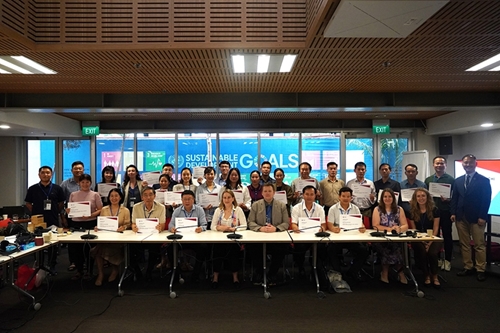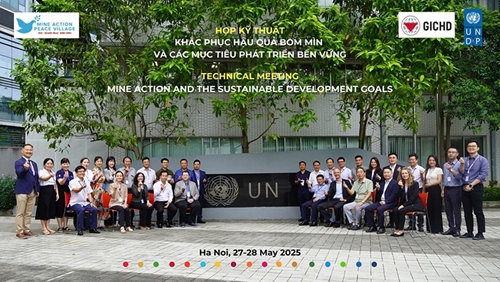The inevitable connection between mine action and the SDGs was discussed at the technical meeting themed “Mine Action and the Sustainable Development Goals,” held on May 27–28 at the Green One U.N. House in Hanoi.
The meeting was jointly organized by the U.N. Development Program (UNDP) in Vietnam and the Vietnam National Mine Action Center (VNMAC), with technical support from the Geneva International Centre for Humanitarian Demining (GICHD), as part of the Vietnam-Korea Peace Village Project (KVPVP). It brought together domestic and international experts from VNMAC and such organizations as KOICA, UNDP, RENEW, NPA, MAG, PeaceTrees, CRS, as well as representatives from KVPVP project management units in Binh Dinh and Quang Ngai provinces and Hue City.
    |
 |
|
The technical meeting draws the participation of representatives from agencies and organizations engaged in war legacy relief in Vietnam. |
Vietnam is among the countries most heavily affected by landmines and post-war unexploded ordnance (UXO). Remaining across approximately 5.6 million hectares of land nationwide, post-war UXO not only threatens human lives but also hinders socio-economic development in many rural, border, and mountainous areas. In recent years, mine action in Vietnam has been implemented comprehensively, achieving many positive results, contributing to stabilizing people’s lives, rehabilitating UXO-contaminated land, and promoting sustainable development.
In 2017, the Government of Vietnam issued the National Action Plan to implement the 2030 Agenda for Sustainable Development (Decision No. 622/QD-TTg), specifying the 17 global goals in targets and indicators suitable to the country’s conditions. On June 15, 2022, the Prime Minister signed Decision No. 841/QD-TTg on the roadmap for the implementation of the SDGs by 2030, with specific timelines for each goal. This provides a basis for ministries, sectors, and localities to develop effective, feasible, and practical action plans.
Vietnam has twice presented its Voluntary National Review (VNR) at the UN High-Level Political Forum, in 2018 and 2023, demonstrating the country’s transparency, responsibility, and strong commitment to deeper international integration.
At the technical meeting, experts and delegates analyzed the close relationship between mine action and the SDGs. Apart from its link to Goal 16 (Peace, Justice, and Strong Institutions), mine action also directly contributes to many other goals such as No Poverty (SDG 1), Good Health and Well-being (SDG 3), Quality Education (SDG 4), Gender Equality (SDG 5), Decent Work and Economic Growth (SDG 8), and Partnerships for the Goals (SDG 17).
Case studies presented at the meeting showed that when mine action is integrated into national and local socio-economic development plans, the outcomes are more sustainable and long-lasting. Mine clearance not only expands safe development space for communities but also creates conditions for building schools, medical facilities, and rural infrastructure. These directly contribute to a higher quality of life.
However, mine action in Vietnam still faces many challenges. These include vast UXO-contaminated areas, complex types of UXO, and limited resources and technology. In particular, the lack of a unified evaluation mechanism at both national and local levels regarding the contribution of mine action to the SDGs remains a “gap” that needs to be addressed.
    |
 |
|
Delegates of the technical meeting in a group photo |
As Vietnam is developing its National Mine Action Program for the 2026–2045 period, with a vision to 2065, the technical meeting provided an opportunity for Vietnam to learn from international experience and affirm the country’s proactive role in global initiatives.
In a broader sense, mine action is a continuation of soldiers’ missions in peacetime—tirelessly protecting public safety and peace while restructuring war-ravaged areas. In recent years, the engineering forces of the Vietnam People’s Army, especially units tasked with UXO disposal, have demonstrated a strong sense of responsibility, coordinated effectively with domestic and international organizations, and gradually reclaimed more land free from UXO contamination for local development.
Integrating mine action into the SDGs is an inevitable, humanistic, and highly strategic direction. This is not only a technical or humanitarian task, but also a national strategy to strengthen internal capacity, build a safe and stable environment for socio-economic development, and protect national sovereignty.
Translated by Chung Anh